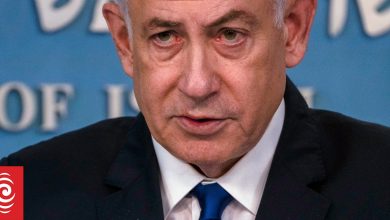Gaza ceasefire plan in balance as US says Hamas proposed ‘changes’

By Tom Bateman, BBC state department correspondent and David Gritten, BBC News
US Secretary of State Antony Blinken says Hamas has proposed “numerous changes” to a US-backed plan for a Gaza ceasefire and hostage release deal, which currently hangs in the balance.
He told reporters in Doha that some of the changes were “workable” and others were not, but that the US and mediators Qatar and Egypt would “try to close this deal”.
Hamas said on Tuesday that it was ready to “deal positively” with the process but stressed the need for Israel to agree to a permanent ceasefire.
Israel’s government has not commented, but an anonymous Israeli official said the Palestinian armed group’s response amounted to a rejection.
On Tuesday, Blinken said Israeli Prime Minister Benjamin Netanyahu had “reaffirmed his commitment” to the ceasefire proposal and that only Hamas stood in the way of progress.
However, Netanyahu has not publicly endorsed the plan, which US President Joe Biden said had been offered by Israel when he outlined it 12 days ago.
The UN Security Council on Monday passed a resolution supporting the proposal, adding to the diplomatic pressure the US is exerting.
The BBC is part of the travelling press pool on the US secretary of state’s visit to Qatar – a glittering Gulf location that belies the sense of regional crisis he is attempting to solve with a diplomatic tour taking place at breakneck speed.
At a news conference with Qatar’s Prime Minister and Foreign Minister, Sheikh Mohammed bin Abdul Rahman Al Thani, Blinken said they had been discussing the changes requested by Hamas to the US-backed ceasefire proposal.
“A deal was on the table that was virtually identical to a proposal that Hamas put forward on 6 May – a deal that the entire world is behind, that Israel has accepted, and Hamas could have answered with a single word: ‘yes’,” he said.
“Instead, Hamas waited nearly two weeks and then proposed more changes, a number of which go beyond positions that it had previously taken and accepted.”
But, he added, US, Qatari and Egyptian officials would “try to close this deal”.
“I believe those gaps are bridgeable. But that doesn’t mean they will be bridged because, ultimately, Hamas has to decide.”
Sheikh Mohammed said both Hamas and Israel needed to make some concessions.
“We are witnessing a shift in this conflict in the recent period and there is a clear and firm call to end this war,” he noted.
Blinken also said it was crucial to develop plans for the “day after the conflict” in Gaza as soon as possible in order to achieve an enduring end to the war.
“In the coming weeks, we will put forward proposals for key elements of a ‘day after plan’, including concrete ideas for how to manage governance, security, reconstruction,” he added.
The brief statement issued by Hamas on Tuesday evening confirming that it had given an official response to the ceasefire proposal did not outline any of the changes it had requested.
However, the group did reiterate a demand for what it called “a complete halt of the ongoing aggression against Gaza” and the full withdrawal of Israeli forces.
A Hamas official, Izzat al-Rishq, said the response was “responsible, serious and positive” and that it opened up “a wide pathway” to reach an agreement.
The Israeli prime minister’s office did not release an on-record reply.
But a statement was issued by an anonymous Israeli official, who said that Hamas had “changed all of the main and most meaningful parameters” and “rejected the proposal for a hostage release that was presented by President Biden”.
The Israeli military launched a campaign in Gaza to destroy Hamas in response to an unprecedented attack on southern Israel on 7 October, during which about 1200 people were killed and 251 others were taken hostage.
More than 37,200 people have been killed in Gaza since then, according to the territory’s Hamas-run health ministry.
A deal agreed in November saw Hamas release 105 of the hostages in return for a week-long ceasefire and some 240 Palestinian prisoners in Israeli jails. Israel says 116 hostages are still being held, 41 of whom are presumed dead.
Biden said the new proposal involved three phases.
The first would involve an initial six-week ceasefire, when Hamas would release some of the hostages – including women, the elderly and the sick or wounded – in exchange for Israel releasing an undefined number of Palestinian prisoners. There would also be a withdrawal of Israeli forces “from all populated areas of Gaza” and a “surge” in humanitarian assistance.
The second phase would see all remaining living hostages released and the withdrawal of all Israeli forces from Gaza as part of a “permanent cessation of hostilities”, but the latter would still be subject to further negotiations.
During the third phase, the remains of any dead hostages would be returned and a major reconstruction plan for Gaza would commence.
While the White House is in effect trying to bounce the sides into progress on an agreement, Israel’s leadership remains deeply sceptical about it.
Far-right ministers are pressuring Netanyahu to ignore Washington’s diplomacy and have threatened to quit his governing coalition and trigger its collapse if the US-backed proposal goes forward, seeing it as a surrender to Hamas.
The prime minister has not unequivocally voiced support for the plan, which he has acknowledged was authorised by his war cabinet.
The actual Israeli proposal – reportedly lengthier than the summary presented by Biden – has not been made public and it is unclear whether it varies from what the president conveyed. It was presented to Hamas days before Biden’s speech.
– BBC
According to the news on Radio New Zealand




